Book contents
- Frontmatter
- Contents
- List of figures
- List of tables
- List of contributors
- Acknowledgements
- 1 What's unique about immigration in Europe?
- 2 Europe's immigration challenge in demographic perspective
- 3 Migration into OECD countries 1990–2000
- 4 Divergent patterns in immigrant earnings across European destinations
- 5 Economic consequences of immigration in Europe
- 6 Occupational status of immigrants in cross-national perspective: A multilevel analysis of seventeen Western societies
- 7 Immigrants, unemployment, and Europe's varying welfare regimes
- 8 How different are immigrants? A cross-country and cross-survey analysis of educational achievement
- 9 Immigration, education, and the Turkish second generation in five European nations: A comparative study
- 10 Managing transnational Islam: Muslims and the state in Western Europe
- 11 Migration mobility in European diasporic space
- 12 The new migratory Europe: Towards a proactive immigration policy?
- 13 European immigration in the people's court
- 14 The politics of immigration in France, Britain, and the United States: A transatlantic comparison
- 15 “Useful” Gastarbeiter, burdensome asylum seekers, and the second wave of welfare retrenchment: Exploring the nexus between migration and the welfare state
- 16 The European Union dimension: Supranational integration, free movement of persons, and immigration politics
- 17 The effectiveness of governments’ attempts to control unwanted migration
- Index
- References
9 - Immigration, education, and the Turkish second generation in five European nations: A comparative study
Published online by Cambridge University Press: 23 June 2009
- Frontmatter
- Contents
- List of figures
- List of tables
- List of contributors
- Acknowledgements
- 1 What's unique about immigration in Europe?
- 2 Europe's immigration challenge in demographic perspective
- 3 Migration into OECD countries 1990–2000
- 4 Divergent patterns in immigrant earnings across European destinations
- 5 Economic consequences of immigration in Europe
- 6 Occupational status of immigrants in cross-national perspective: A multilevel analysis of seventeen Western societies
- 7 Immigrants, unemployment, and Europe's varying welfare regimes
- 8 How different are immigrants? A cross-country and cross-survey analysis of educational achievement
- 9 Immigration, education, and the Turkish second generation in five European nations: A comparative study
- 10 Managing transnational Islam: Muslims and the state in Western Europe
- 11 Migration mobility in European diasporic space
- 12 The new migratory Europe: Towards a proactive immigration policy?
- 13 European immigration in the people's court
- 14 The politics of immigration in France, Britain, and the United States: A transatlantic comparison
- 15 “Useful” Gastarbeiter, burdensome asylum seekers, and the second wave of welfare retrenchment: Exploring the nexus between migration and the welfare state
- 16 The European Union dimension: Supranational integration, free movement of persons, and immigration politics
- 17 The effectiveness of governments’ attempts to control unwanted migration
- Index
- References
Summary
Introduction
Research on the second generation of postwar immigrants is a relatively new phenomenon. Only in the past decade has it become a central focus in the study of immigrant integration. The postwar second generation in Europe came of age at roughly the same time as the American one – and that was when researchers began exploring it more systematically. Examples of early studies in various European countries are Seifert (1992), Crul (1994), Tribalat (1995), Veenman (1996), and Lesthaeghe (1997). International comparative research on the second generation is still scant. In fact, only one such venture has been undertaken – the EFFNATIS project, conducted from 1998 to 2000 by researchers in eight European countries (EFFNATIS, 2001). Because EFFNATIS focused on different ethnic groups in different countries, no comparisons could be made of how the same ethnic group had fared in different settings. Cross-national comparisons were, therefore, awkward to make (Crul and Vermeulen 2003).
The primary focus of this chapter is the comparison of integration processes in different countries. This is an aspect that has received far more attention in European than in American research. More specifically, we compare the integration of second-generation Turkish immigrants in five European countries: Germany, The Netherlands, Belgium, France, and Austria. This focus on immigrants from a single source country offers a complementary contrast to chapter 8 by Schnepf, as does a focus on educational attainment rather than achievement.
- Type
- Chapter
- Information
- Immigration and the Transformation of Europe , pp. 235 - 250Publisher: Cambridge University PressPrint publication year: 2006
References
- 15
- Cited by

